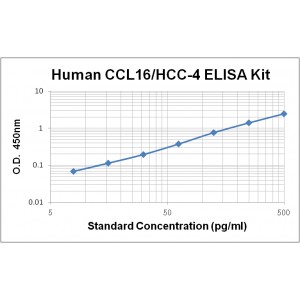More info
Assay Range | 7.8 - 500 pg/mL |
Sensitivity | 10.0 pg/mL |
Size | 96T |
Storage | Store at 2 - 8ºC. Keep reconstituted standard and detection Ab at -20 ºC |
Assay Principle | Sandwich ELISA |
Sample Volume | 100 µL final volume, dilution factor varies on samples |
Detection Method | Chromogenic |
Kit Components
1. Recombinant Human CCL16 standard: 2 vials
2. One 96-well plate coated with Human CCL16 Ab
3. Sample diluent buffer: 12 mL - 1
4. Detection antibody: 130 µL, dilution 1:100
5. Streptavidin-HRP: 130 µL, dilution 1:100
6. Antibody diluent buffer: 12 mL x1
7. Streptavidin-HRP diluent buffer: 12 mL x1
8. TMB developing agent: 10 mL x1
9. Stop solution: 10 mL x1
10. Washing solution (20x): 25 mL x1
Background
Chemokine (C-C motif) ligand 16 (CCL16), also known as chemokine CC-4 (HCC-4), liver-expressed chemokine, lymphocyte and monocyte chemoattractant (LMC), small-inducible cytokine A16 (SCYA16), is a small cytokine belonging to the CC chemokine family. CCL16 is synthesized as a 120 amino acid (aa) precursor protein containing a 23 aa predicted signal peptide and a 97 aa mature protein. CCL16 is a novel CC chemokine and distantly related to other CC chemokines, exhibiting less than 30% aa sequence identity. Among these CC chemokines, CCL16 has the most similarity to CCL14/HCC-1. CCL16 is expressed weakly by some lymphocytes, including NK cells, γδ T cells, and some T cell clones. The expression of CCL16 in monocytes is highly upregulated upon IL10 stimulation. Recombinant CCL16 has exhibited chemotactic activities on human monocytes and THP1 cells but not resting lymphocytes or neutrophils. CCL16 has also been found to suppress proliferation of myeloid progenitor cells. In addition, CCL16 can induce calcium flux in THP1 cells and this effect can be desensitized by prior exposure to RANTES, suggesting that CCL16 and RANTES use the same signaling pathways in THP1 cells. CCL16 elicits its effects on cells by interacting with cell surface chemokine receptors such as CCR1, CCR2, CCR5 and CCR8.


